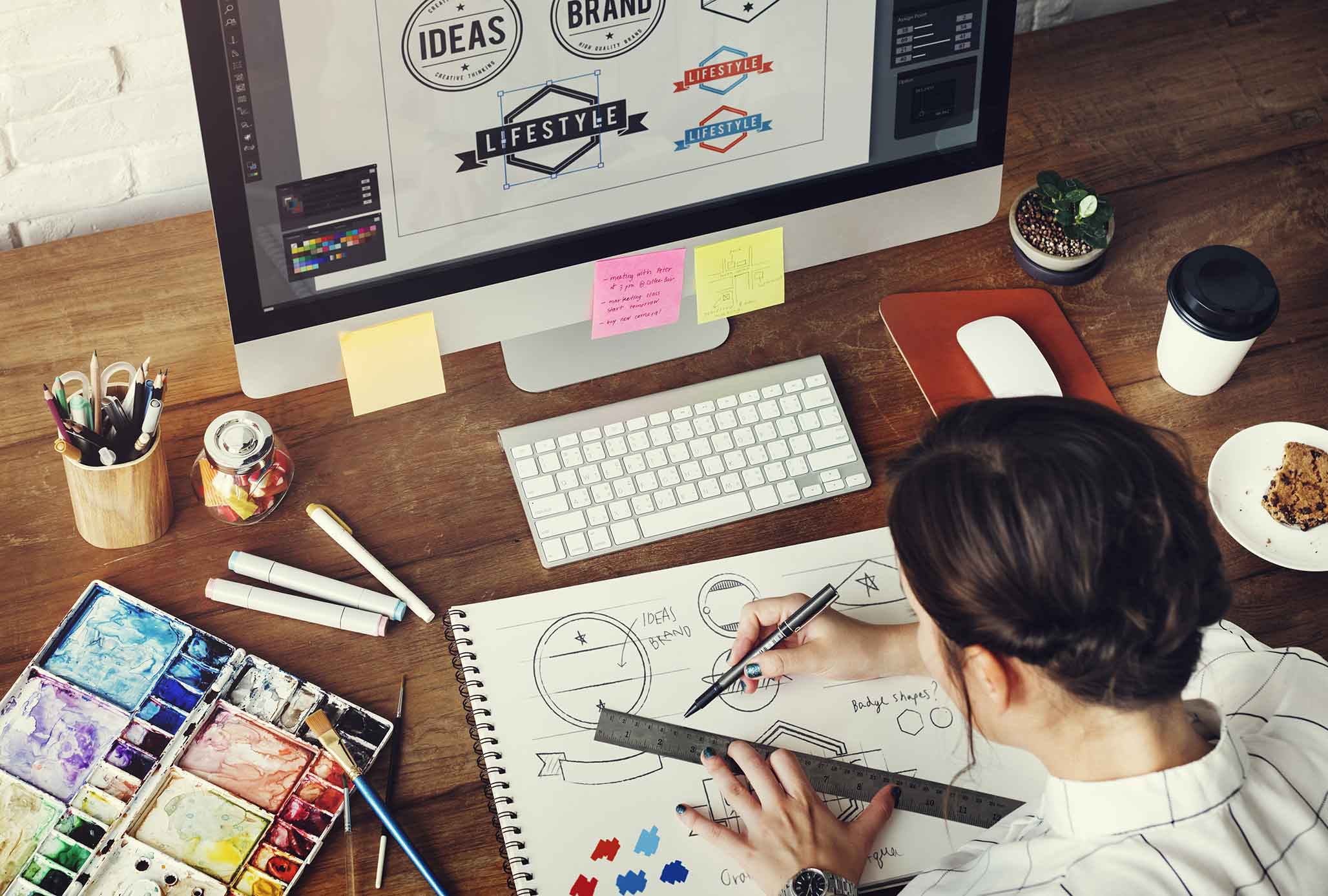Blending creative expression with goal-driven communication, graphic design represents a powerful application of fine arts. The goal: to shape the viewer’s perception through the strategic use of layout, typography and imagery.
This nuanced field is better understood when dividing its two core terms: graphic and design. Graphic refers to the visual elements that make viewers take notice. From color to texture, these essentials allow graphic designers to convey complex ideas. Design, meanwhile, reveals how the final product will look and function. This helps ensure there is substance behind the graphic designer’s work.
Graphic designers share a commitment to fulfilling the principles of design while also emphasizing creative expression through graphic elements. However, how exactly they accomplish this depends greatly on the needs of the client and the preferences of the target market.
To clarify this far-reaching role and all it encompasses, we provide an in-depth answer to the key question: What does a graphic designer do?
What Does a Graphic Designer Do?
No two days look exactly alike for the modern graphic designer, who enjoys the unique opportunity to build creative expression into every professional pursuit. What, then, separates a graphic designer from an artist or other creative professionals?
According to the United States Bureau of Labor Statistics (BLS), graphic design centers on visual concepts but with the main purpose of communicating ideas to influence consumers.
To accomplish this, graphic designers develop strategic layouts as well as create logos, illustrations, and other imagery. Along the way, they communicate extensively with clients and other team members to ensure projects remain on track.
Core Responsibilities
Graphic designers hold a variety of responsibilities, which may vary slightly based on where they work and which mediums they focus on. In general, though, this role involves a few key tasks:
- Discuss and determine project scope alongside clients or marketing managers.
- Use software to create visual designs that reflect the brand or the client’s preferred style.
- Carefully select colors, typefaces and other elements that impact how designs are perceived.
- Present design drafts to clients and make revisions as necessary.
Skill Set Needed for a Graphic Designer
Graphic designers draw on a vast skill set that includes not only elite artistry but also strong communication and technical acumen.
- Technical skills and software proficiency – Technical mastery is increasingly important for graphic designers, especially as this field continues to transition towards digital messaging. These days, employers value job candidates with a thorough understanding of user experience (UX) and user interfaces (UI), including interactive elements. What’s more, today’s graphic designers rely on software solutions such as Adobe Photoshop. Graphic designers should be willing to explore and master new software and applications as they become available.
- Creativity and originality – Graphic designers need to make their work stand out while remaining consistent with the brands they represent. Creativity allows these imaginative professionals to find new ways to share familiar messages. Unique designs make a stronger impression on target customers or clients, while innovative (and often interactive) elements produce greater engagement.
- Communication and client handling – Graphic design is all about communicating through visual methods, but many other facets of communication play into this field. Verbal and written communication skills must be thoroughly developed, as these allow designers to effectively convey their vision and their process to clients. Communication also determines how graphic designers work with other professionals.
- Attention to detail – Every element of every design must be carefully considered and ultimately polished. Ideally, clients will not need to ask for significant revisions; attention to detail can ensure that designs exceed their expectations. This quality must be evident while analyzing creative briefs, developing drafts and especially for quality assurance (QA) purposes.
For a deeper dive into other skills and proficiency necessary for graphic designers today Indeed offers a more comprehensive guide that emphasizes the blend of creativity and technical acumen required in the field.
Graphic Design Process
Inspiration can strike at any moment, but graphic designers bring structure to their work by following a step-by-step process:
- Briefing – Graphic design projects begin with creative briefs, which highlight everything from deadlines to measurable objectives. These details help graphic designers align their process with the needs and goals of the client. Designers must take the time to examine each brief and determine how these instructions and objectives will play into the project and the general design process.
- Research – Extensive research is essential, as designers must understand the needs and preferences of the audience or end users. Market research is a must, but this process may also encompass competitor analysis, site research or user testing.
- Brainstorming concepts – Following an extensive research process, designers should be ready to move forward with brainstorming concepts. Inspiration can take numerous forms, with many designers relying on mood boards to experiment with groundbreaking ideas.
- Sketch and wireframe – Brainstorming is a deeply creative process, but the concepts that emerge must eventually be grounded in reality—hence the need for practical sketches and wireframes. The sketch represents a rough image that indicates how the final product might look. Meanwhile, the wireframe acts as a schematic and can play heavily into UX and UI design.
- Digital drafting – Many designers rely on software to create two and three-dimensional drafts. This tends to be a more efficient process, and the ensuing mockups can easily be updated or modified as necessary.
- Feedback and revisions – Following the hard work of brainstorming and drafting, it’s time to reveal the design. This may result in extensive feedback, along with the need for revisions. Clear and open communication can make this process easier. Also crucial? Tracking changes and being willing to push back on occasion.
- Production and QA – Every aspect of every design must be cross-checked to ensure accuracy and quality. Once this quality assurance process has been completed, the project can finally move into the production phase.
- Delivery and approval – When designers and clients are on the same page, swift approval is likely. In some cases, approval relies on both the thoughts and opinions of the client or stakeholders along with user testing. Feedback obtained at this point (or through metrics gathered later on) can be incorporated as graphic designers return to step one and begin analyzing new creative briefs.
For another viewpoint of each step in the graphic design process and the importance of following a detailed workflow, HubSpot provides an insightful overview and further elaboration on this subject.
Industry Applications
Graphic design is an increasingly diverse field that encompasses a range of exciting digital and print opportunities. Across many industries and within organizations of all kinds, there is a strong need for graphic designers who can convey key concepts in a way that resonates with target consumers. Common applications include:
Advertising and Marketing
Graphic designers often play a central role in marketing teams, where they may work alongside other skilled professionals to help shape the direction and implementation of numerous campaigns or initiatives. They may be a core member of such teams or may simply consult with marketing departments to better align their imagery with branding efforts.
Through consistent and carefully curated visuals, graphic designers can amplify marketing campaigns and improve outcomes. Roles that blend these two areas are increasingly common, with emerging positions including marketing graphic designer or graphic design specialist.
Web and UX Design
Web and UX designers frequently have a strong background in graphic design, which allows them to bring a more cohesive and aesthetically appealing look to the websites or applications they design. The main difference? While graphic design emphasizes how visual elements are brainstormed or created, web and UX design aim to organize those visual elements to promote seamless navigation.
As in marketing, many UX and UI-centric jobs integrate graphic design to great effect. UX graphic designers, for example, showcase their creativity as well as bring practical concerns to the forefront when designing application interfaces or other digital assets.
Print and Publication
The origins of graphic design lie within print media, and while digital-oriented jobs are more common these days, there are still plenty of compelling print design opportunities. These allow graphic designers to reveal their concepts in a tangible form, which may involve banners, brochures or even T-shirts. In addition, many graphic designers work in journalism, with their creativity on display in magazines and newspapers.
Tools of the Trade
Graphic designers rely on various tools to expedite the process while helping them bring creative concepts to life and avoid design errors. Preferred tools depend largely on the project and the client in question, but most designers will work with these essentials at some point:
Graphic Design Software
We have already touched on the need for aspiring graphic designers to develop proficiency with many software solutions. Advanced software provides easy access to helpful templates and other tools but leaves plenty of room for customization, too. Top software solutions currently used in graphic design include:
- Adobe Photoshop
- Adobe Illustrator
- Adobe Creative Cloud Express
- Canva
- Autodesk Maya
- Affinity Photo
- GIMP
Emerging Trends
Graphic design, like any creative field, is heavily influenced by trends. These are often evident beyond the world of graphic design, with developments from fashion and interior design frequently coming into play. Noteworthy trends currently taking over include:
- Maximalism
- Retro pixels
- Surrealism
- Sustainability
- Hand-drawn
Education and Career Path
There are a number of ways to break into graphic design. Increasingly, however, employers seek well-trained designers with strong academic credentials. College-level training is a must because it exposes aspiring graphic designers to the many nuances of this field—for example, communicating with clients or navigating cutting-edge software.
The Bachelor of Fine Arts in Graphic Design provides ample opportunities to not only develop a powerful creative vision but also learn and apply a variety of skills that are critical to success in the competitive world of graphic design. Additionally, this can be a great opportunity for networking with the field’s most promising designers, not to mention experienced and fascinating faculty members.
Future of Graphic Design
The future of graphic design is bright, but with a caveat: Change is definitely afoot. New technologies will force designers to grapple with new ways of working and, in some situations, new sources of competition. Artificial intelligence (AI) in particular promises to usher in major changes. Implemented correctly, AI tools can streamline workflows and allow designers to focus more on brainstorming and creative conceptualization.
Virtual reality (VR) and augmented reality (AR) are also poised to make a splash in graphic design and marketing in general. Through VR solutions, designers can observe their drafts in three-dimensional form, thereby enhancing spatial understanding.
What’s more, VR environments themselves often call for expertise from graphic designers, many of whom appreciate the wealth of creative opportunities that this platform provides. As designers embrace VR and AR, already-immersive visual experiences will become that much more compelling.
Prepare for a Bright Future in Graphic Design
If you have a creative eye but also feel drawn to opportunities in technology and communication, you could have the makings of an amazing graphic designer. First, though, you will need targeted training, as this field now calls for a distinct blend of soft and technical skills that can be difficult to develop.
Let RMCAD guide you through this process and help you embrace exciting graphic design opportunities. Our Bachelor of Fine Arts in Graphic Design can equip you with the skill set required in today’s most dynamic creative fields. This program is available online or on campus, so you can broaden your horizons as it fits with your lifestyle. Reach out today to learn more.

